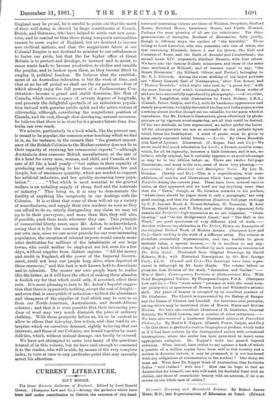CURRENT LITERATURE.
GIFT BOOKS.
some and interesting volume are those of Windsor, Deepdene, Stafford House, Hertford House, Grosvenor House, and Castle Howard. Perhaps the most pleasing of all are the miniatures. The three presentations of Georgina, Duchess of Devonshire, fully justify, though in different ways, the epithet of "the beautiful." These belong to Lord Lanerton, who also possesses two sets of seven, the first containing Elizabeth, James I. and his Queen, the Earl and Countess of Essex, and the Earls of Arundel and Cumberland ; the second, Louie XIV. (repeated), Cardinal Mazarin, with four others- We have also the famous Holbein miniatures, and those of the same time attributed to Hilliard ; and of interest equal to any, "the Stuart Miniatures " (by Hilliard, Oliver, and Petitot), belonging to Mr. E. J. Edwards. Among the most striking of the larger pictures are "Henry Howard, Earl of Northampton," after Van Somer, and " Thomas Teesdale," which might take rank as " a green boy," with the more famous rival which Gainsborough drew. These works of art have been successfully reproduced by photography.--Evangeline, by H. W. Longfellow, with illustrations by Frank Dicksee, A.R.A.,. (Cassell, Petter, Galpin, and Co.), with its handsome appearance and stately proportions, its highly decorated binding and India paper, seems a setting almost too fine, though not too valuable, for the poem which it reproduces. But Mr. Dicksee's illustrations, given effectively by photo- gravure or by vigorous wood-engraving, are all that could be desired. Of the two methods, as here represented, we rather prefer the latter All the photogravures are not so successful as the pathetic figure which forms the frontispiece. A word of praise must be given to some neatly executed initial letters.—Lucile. By Owen Meredith (the Earl of Lytton). Illustrated. (C. Kegan Paul and Co.)—We never could feel much admiration for Lucile, a French novel in verse, which, for all its ingenuity, becomes a little tiresome, and is not, we believe, wholly original, but it certainly appears to as good advantage as may be in the edition before us. There are twelve full-page illustrations, and many in the text, some of them very pleasing.— Lancashire ; Brief Historical and Descriptive Notes. By Leo H. Grindon. (Seeley and Co.)—This is a republication, with some additions, of articles and illustrations which have appeared in the Portfolio during the current year. These have been noticed once or- twice, as they appeared, and we need not say anything more than that the " Notes," though, as Mr. Grindon remarks in his preface,. " where there should be pages there is only a paragraph," are very good reading, and that the illustrations (fourteen full.page etchings by C. P. Jacomb Hood, A. Brunet-Debaines, H. Toussaint, R. Kent Thomas, David Law, and T. Riley, and about thirty vignettes) fully sustain the Portfolio's high reputation as an art magazine. " Glass- blowing," and " On the Bridgewater Canal," and " The Hall in the Wood," are good specimens of very different kind of work.— Another welcome republication is The Etcher, Thirty-six Examples of the Original Etched Work of Modern Artists. (Sampson Low and Co.)—Each etching is the work of a different artist. The volume is therefore remarkably representative, and has, besides its great intrinsic value, a special interest.—It is needless to say any- thing of a book which comes fortified by such names as recommend The Holy Land. Illustrated from Original Drawings by David Roberts, R.A., with Historical Descriptions by the Rev. George Croly, LL.D. (Cassell and Co.)—The drawings have been repro. duced in lithograph by Mr. Louis Haghe. The volume before us gives the first division of the work, "Jerusalem and Galilee."— Men of Mark ; Contemporary Portraits of Distinguished Men. With Brief Biographical Notices. By Thompson Cooper, F.S.A. (Sampson Low and Co.)—This " sixth series " presents us with the usual num- ber (thirty-six) of specimens of Messrs. Lock and Whitfield's artistic skill. The place of honour is occupied by an excellent portrait of Mr. Gladstone. The Church is represented by the Bishop of Bangor and the Deans of Chester and Llandaff. Art furnishes nine portraits, among which may be mentioned those of Messrs. Watts and Britten Riviere. We have also excellent likenesses of M. Gambetta, General Roberts, Sir Wilfrid Lawson, and a number of other celebrities.— We have also received a handsome illustrated edition of Proverbial Philosophy. By Martin F. Tupper. (Cassell, Potter, Galpin, and Co.) —To this there is prefixed a curious biographical preface, which looks as if it had been written by the distinguished author with occasional interruptions, where the scribe has been permitted to insert some appropriate eulogium. Dr. Tupper's work has passed beyond criticism. What, indeed, have critics to say against a book of which a quarter of a million copies have been sold in this country and a million in America (where, it may be presumed, it is not burdened with any obligations of remuneration to the author) ? One thing we must ask. What does Dr. Tupper think of Aristarchns, that he thinks Zoilus " well clubbed" with him ? How can he hope to find an Aristarchns for himself, one who will mark his doubtful lines with an obelisk, and those of remarkable beauty with an asterisk, if he is so severe on the whole race of critics?






































 Previous page
Previous page